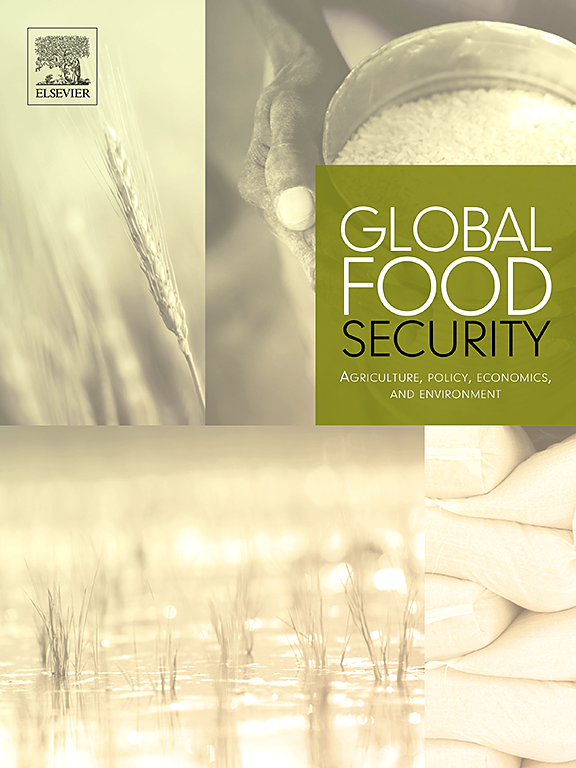Severe food insecurity among middle-aged and older adults in India: Insights from the Longitudinal Aging Study in India
IF 9.6
1区 经济学
Q1 FOOD SCIENCE & TECHNOLOGY
Global Food Security-Agriculture Policy Economics and Environment
Pub Date : 2025-02-10
DOI:10.1016/j.gfs.2024.100822
引用次数: 0
Abstract
Severe food insecurity (SFI) is a critical concern in India, yet few studies have highlighted national and state trends among Indian adults. Utilizing data from 63,525 adults aged 45 and above from the Longitudinal Aging Study in India (2017-18), we present noteworthy geographic and sociodemographic patterns in the distribution of SFI. We estimate the national prevalence to be 6.2% (95% CI: 5.6, 6.8). Madhya Pradesh had the highest prevalence of SFI (10.3%), followed by Jharkhand, Tamil Nadu, and Bihar. Conversely, Nagaland, Goa, Lakshadweep, and Arunachal Pradesh had the lowest prevalence (all under 2.0%). Living in a rural area, being widowed, belonging to a Scheduled Caste, and being Muslim were positively associated with reporting SFI. Additionally, those in the middle and richer household monthly per capita expenditure quintiles, with 6–9 years of schooling, who resided in the country's northern and northeastern regions, or who had never worked for more than three months in their lifetime, were less likely to report SFI. We also find that geography and socioeconomic status synergistically affect SFI. Specifically, adults with lower levels of education were at a greater risk of SFI in rural areas, relative to urban areas, and the Central and East regions of India, relative to the North. Our findings highlight the need for robust state-level policies to ensure equitable access to affordable, high-quality food for all Indian adults, particularly for those belonging to at-risk groups.
印度中老年人严重的粮食不安全:来自印度纵向老龄化研究的见解
严重的粮食不安全(SFI)是印度的一个重要问题,但很少有研究突出了印度成年人的国家和州趋势。利用来自印度纵向老龄化研究(2017-18)的63,525名45岁及以上成年人的数据,我们展示了SFI分布中值得注意的地理和社会人口模式。我们估计全国患病率为6.2% (95% CI: 5.6, 6.8)。中央邦的SFI患病率最高(10.3%),其次是贾坎德邦、泰米尔纳德邦和比哈尔邦。相反,那加兰邦、果阿邦、拉克沙德邦和**的患病率最低(均低于2.0%)。生活在农村地区、丧偶、属于既定种姓和穆斯林与报告SFI呈正相关。此外,那些中等和较富裕家庭的月人均支出五分之一,受过6-9年教育,居住在该国北部和东北部地区,或一生中从未工作超过三个月的人,报告SFI的可能性较小。我们还发现地理和社会经济地位对SFI有协同影响。具体来说,教育水平较低的成年人在农村地区相对于城市地区,在印度中部和东部地区相对于北部地区,有更大的SFI风险。我们的研究结果强调,需要制定强有力的州一级政策,以确保所有印度成年人,特别是那些属于高危群体的成年人,公平地获得负担得起的高质量食物。
本文章由计算机程序翻译,如有差异,请以英文原文为准。
求助全文
约1分钟内获得全文
求助全文
来源期刊

Global Food Security-Agriculture Policy Economics and Environment
FOOD SCIENCE & TECHNOLOGY-
CiteScore
20.90
自引率
3.40%
发文量
69
期刊介绍:
Global Food Security plays a vital role in addressing food security challenges from local to global levels. To secure food systems, it emphasizes multifaceted actions considering technological, biophysical, institutional, economic, social, and political factors. The goal is to foster food systems that meet nutritional needs, preserve the environment, support livelihoods, tackle climate change, and diminish inequalities. This journal serves as a platform for researchers, policymakers, and practitioners to access and engage with recent, diverse research and perspectives on achieving sustainable food security globally. It aspires to be an internationally recognized resource presenting cutting-edge insights in an accessible manner to a broad audience.
 求助内容:
求助内容: 应助结果提醒方式:
应助结果提醒方式:


